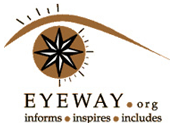How to make cultural spaces more accessible for the differently abled is now the prime agenda for museums and galleries. While National Museum plans to come up with a special gallery for the visually impaired, some galleries are making necessary infrastructural changes
One of the many other things that make Louvre museum in Paris a must-visit destination is the fact that it has probably the best designed model to suit the need of differently-abled visitors. The museum not only offers facilities like wheelchairs (on loan) and adapted activities and workshops for the specially-abled, it also has touch tours, descriptive tours, information in Braille and audio tours for the visually impaired. The Touch Gallery is designed for the sight impaired. It allows all visitors to share a touch perception experience. One can discover 18 moulds of antiquity artwork from the 19th century, giving an idea of the different ways childhood was represented over the centuries. For the hearing impaired, there are tours in French sign language, lip reading or cued speech and there are adapted tours and activities for mentally disabled. Louvre museum and other disabled-friendly cultural hotspots of the world like The Tate Modern Museum in London, The Metropolitan Museum of Art, New York and The Henry Ford Museum and Greenfield Village in Dearborn are now being looked upon as ideal case studies to make cultural spaces in the city more disabled-friendly.
While so far, we do not have many examples of disabled-friendly cultural hubs in the city, the change seems to be in progress with galleries now becoming more sensitive towards the need of specially-abled and National Museum taking a necessary step in this regard. Last year, the National Museum participated in the special session convened by UNESCO New Delhi Culture Sector on ‘ICT-enabled Participation of PWDs in Arts and Cultural Life’. It was held during the National Conference and Exhibition on the theme ‘ICTs for Persons with Disabilities: Taking Stock and Identifying Opportunities’, a joint initiative by UNESCO and the Open Knowledge Community (Ministry of Communications and IT), wherein they discussed how to make the museums more inclusive by enhancing the accessibility and the learning experience of the persons with disabilities (PWDs). As an immediate follow up to this session, National Museum offered to review its current services and experiment the development of new facilities for PWDs. An informal voluntary group was formed since then at the National Museum with the participation of UNESCO New Delhi Culture Sector, Saksham, National Platform for the Rights of the Disabled (NPRD), Beyond Sight Foundation, Deakin University, Google Cultural Institute and School of Planning and Architecture, Bhopal to explore feasibility of introducing various services to enhance the accessibility of the PWDs. “Post that conference, we have been discussing how to make cultural spaces accessible to disabled people. We first plan to come up with special facilities for visually impaired and we are planning to have a special gallery for them with replicas of artworks and technological interface. As a pilot project we decided to design one of our exhibitions, Cadence and Counterpoint: Documenting Santal Traditions, for the visually impaired. A guided ‘touch tour’ of the selective objects at the exhibition will be organised for a group of visually impaired people to experience the joy of learning about the various instruments, arts and culture which they are otherwise deprived of,” shares Joyoti Roy, the head of outreach department of National Museum.
National Museum, in collaboration with Culture Sector of UNESCO is organising a workshop, titled Making Museums Accessible for Persons with Disabilities, to sensitise the museum professionals on the available policies. Case studies will be shared to help museums come up with services to improve the experience for specially abled. “There is a huge gap between what is available and what needs to be done. To make the museums disabled-friendly, there have to be infrastructural changes. The workshop aims at spreading awareness among museum professionals on available policies and services to improve the museum experience of PWDs. We are looking at case studies from across the globe as models to come up with more solutions and facilities,” says Moe Chiba, programme specialist for culture, UNESCO.
Galleries around the city are making gradual changes but we still have a long way to go. Says Roshini Vadehra, director, Vadehra Art Gallery, “Unfortunately, most of the city is not disabled-friendly. Elevators and ramp access is important at all the cultural hubs in the city. But infrastructural changes to suit the requirements of the disabled-friendly depend on lot of factors like the area available and funds.”
Gallery owners feel that there should be more examples for people to follow. “It is the effort that counts, so each gallery can try, in one way or the other, to have one disabled-friendly feature and that can bring a lot of difference,” says a gallery owner
Source: http://www.dailypioneer.com/vivacity/enable-art-for-all.html

Facebook comments